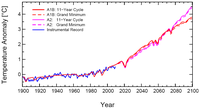
“The notion that we are heading for a new Little Ice Age if the Sun actually entered a Grand Minimum is wrong,” says Georg Feulner, lead author of the study. “In fact,” he adds, “a minimum of solar activity would not prevent strong future warming if emissions of greenhouse gases continued at current levels.”
The observations of sunspots, visible signs of increased solar activity and irradiance, show that the Sun has been in the deepest and longest activity minimum for almost a century. Satellite measurements confirm that solar radiation has never been weaker since records started in the 1970s. Some solar physicists have suggested this could indicate the beginning of a new Grand Minimum comparable to the Maunder Minimum in the late 17th century. The Maunder Minimum is connected to the Little Ice Age with markedly lower temperatures.
To explore the effect of a 21st-century Grand Minimum Feulner and Stefan Rahmstorf of the Potsdam Institute for Climate Impact Research used a coupled climate model that consists of models for the oceans, the atmosphere and the land surface. The researchers studied greenhouse gas emission paths corresponding to the A1B and A2 scenarios of the IPCC with intermediate and strong growth of emissions during the 21st century. The authors also accounted for volcanic eruptions, which are unpredictable, by randomly spreading the same eruptions as in the 20th century over the 21st century.
They performed three simulation experiments with different solar forcing: one without a Grand Minimum, repeating the last 11-year solar activity cycle until 2100, and two with the Sun entering a new Grand Minimum lasting till the end of the century. In these minima, solar irradiance is reduced by 0.08 and 0.25 percent of its value in 1950, the former value corresponding to the reconstructed reduction of solar irradiance during the Maunder Minimum.

With an 11-year solar activity cycle continued until 2100, global temperatures are modelled to rise 3.7 or 4.5 degrees Celsius above the 1961 to 1990 average level, depending on the emission scenario. These results agree well with recent projections, the authors report. For the reconstruction of the Maunder Minimum under the two IPCC emission scenarios, the temperatures in 2100 lie about 0.1 degrees Celsius lower. For the experiment with a stronger reduction of solar irradiance of 0.25 percent of the 1950 value, the difference is 0.26 degrees Celsius under both emission scenarios.
“Most likely, a new Grand Minimum of solar activity would diminish global mean temperatures in the year 2100 by about 0.1 or 0.2 degrees Celsius,” says Stefan Rahmstorf, head of Earth System Analysis at PIK. Even taking into account all uncertainties in the temperature reconstruction, the forcings, and the model physics, the overall uncertainty is estimated to be at most a factor of three, so the solar cooling effect would very likely not exceed 0.3 degrees.
“A new Maunder-type solar activity minimum cannot offset the global warming caused by human greenhouse gas emissions,” the authors conclude. Moreover, any offset of global warming due to a Grand Minimum of solar activity would merely be a temporary effect, since solar minima typically last for several decades to a century at most.
“Current temperature data also confirm that the effect of low solar activity on the climate is very small”, notes Rahmstorf. The current minimum has not noticeably slowed down global warming. Over the past 30 years temperatures have increased at a steady rate of 0.16 degrees Celsius per decade. According to the surface temperature analysis by NASA’s Goddard Institute for Space Studies, the year 2009, despite the solar minimum, was the second-warmest year on record globally, beaten only by 2005, and by far the warmest in the southern hemisphere. The month of January 2010 was the second warmest January on record globally, beaten only by January 2007.
Article: Feulner, G., and S. Rahmstorf (2010), On the effect of a new grand minimum of solar activity on the future climate on Earth, Geophys. Res. Lett., 37, L05707, doi:10.1029/2010GL042710
Further reading:
Goddard Institute for Space Studies Surface Temperature Analysis
http://data.giss.nasa.gov/gistemp/
The Sunspot Cycle (Marshall Space Flight Center)
http://solarscience.msfc.nasa.gov/SunspotCycle.shtml
Solar and Heliospheric Observatory (ESA and NASA)
http://soho.esac.esa.int/
For further information and interviews, please contact the PIK press office:
Phone: +49 331 288 25 07
E-mail: press@pik-potsdam.de





